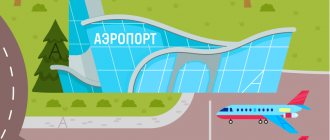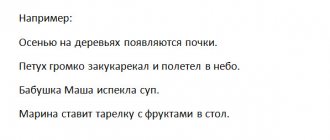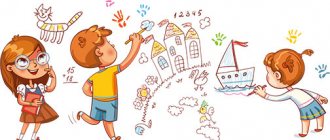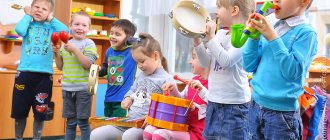Sound games for children 2-3 years old
Preventing a lack of sound pronunciation can be easier than eliminating it at an older age, since the child quickly gets used to speaking incorrectly.
The formation of the correct pronunciation of sounds in words and phrases depends on clarifying and consolidating their pronunciation in isolated form or in simple sound combinations.
Work should begin with mastering simple sounds that children already know how to pronounce clearly, since along with the development of articulation, preparation will occur for the assimilation of more complex sounds. Next comes the consolidation of the pronunciation of sounds in words - in this case, you need to pay attention to the fact that the child learns to speak them clearly and distinctly.
Sound "A"
- Remember with your child the fairy tale “Ryaba Hen” and invite the child to show how the grandfather and grandmother cried (“Ah-ah”). - Show your child a picture of a goose, and ask him to depict how the goose “speaks” (“Ga-ha”), then show a picture of a frog, let the child show you how it croaks (“Kwa-kwa”). Alternate the pictures shown.
Sound "U"
— Place your arms out to the sides with your child, pretending to be airplanes. Shake your “wings”, making an airplane droning sound: “Woo-hoo-hoo-hoo.”
— Show your child three toys (or pictures): a cow, an owl and a cuckoo. Ask them to voice these animals.
Sound "I"
- You and your child are horses. “Jump” around the room, making the sound “Ee-e-e, Ee-e-e, Ee-e-e.” - Now play donkeys. Let the child imitate how the donkey “speaks” (“Eeyore”). - Show your child images of a chicken and a mouse and ask them to imitate their voices (“Pee-pee-pee”).
Sound "O"
- Show your child a doll with a bandaged cheek and tell her that her teeth hurt: “O-O-O.” Ask your baby to repeat the sound. — Ask your child how the chicken “speaks.” Pretend to be chickens with your child (flap your wings and walk around the room), saying: “Ko-ko-ko.”
Sound "Y"
— We depict angry lions: “Y-y-y.”
— We depict a steamer with the palm of our hand with the thumb extended upward. The steamer floats along the river: “Y-y-y” (we move our hand on the table).
Sound "E"
— Invite your baby to laugh silently: “EEE.”
— Together with your baby, sing the echo song: “Uh-uh, uh-uh, uh-uh, uh-uh.”
— You show the child either a picture of a goat or a sheep, and the child says: “Me-uh” or “Be-uh.”
Sounds "M" and "M'". (a comma on top indicates a soft pronunciation of the sound, as in the word “ball”)
— You will be a cow, and the child will be a kitten. You must speak to each other in the language of your animals. You say: “Moo,” the child answers you: “Meow,” etc. Then switch roles and resume the “dialogue.”
— Make small sketches for your child of objects that begin with the sound “M” or “M'”: car, raspberry, fly agaric, fly, soap, milk and mill, ball, honey, bear, etc.
Sounds "N" and "N'"
— You and your child pretend to ride a horse and shout: “But, but”!
— Show your child pictures with different images and call them in unison: “Nose”, “Knife”, “Sock” - and also: “Sky”, “Thread” - etc. Then point to the picture and ask the baby what he sees in it.
Sounds "P" and "P'"
— Tell your child a fairy tale and let him repeat the highlighted words after you. “The chicken decided to bake pies . She kneaded the dough and set it to rise. How does the dough puff? “Puff-puff.” Then the chickens came running and started asking for something to drink. How do chickens ask for water? "Peep-pee." And while the hen was pouring water for the chickens, the dough ran away.
— Invite your child to sing the chicken song: “Pee-pee-pee.”
Sounds "B" and "B'"
- We clap our lips and sing: “Ba-ba-ba, bo-bo-bo.” — Pretend with your baby that you are driving cars. And when you are in danger of crashing into each other, beep at each other: “Beep.”
Sounds "T" and "T'"
— Say: “Knock, knock, knock,” and ask your child who knocks like that. If the child says it is a hammer, show him a hammer toy that you have prepared in advance. If he says it’s a woodpecker, show him a toy or a picture of a woodpecker.
Say again: “Knock-knock-knock,” and ask: “Who’s knocking now?” If there is any difficulty, help the baby with guiding questions. You can play this game, you will say “knock-knock-knock”, and the child will guess who or what knocked. There is no right answer in this game - either a hammer or a woodpecker can knock here. Next time you can add a new sound: “Tick-tock” (clock), and ask where such a sound might come from.
Sounds "D" and "D'"
— Place a bell and a pipe on the table in front of the baby. Ring the bells and say that the bell is ringing: “Ding-ding.” Then blow the pipe and say that the pipe is blowing: “Doo-doo.” You will say: “Ding-ding,” or “Doo-doo,” and the child will play the appropriate musical instrument. Then switch roles.
— Draw for your child objects that begin with the sounds “D” or “D'”: a house with smoke from a chimney, a girl, a sofa, a melon, a tree, a dinosaur, etc.
Sounds "K" and "K'"
— Place two pictures of a chicken, a rooster and a cuckoo in front of the child. Ask who says: “Ko-ko”? And who says: “Ku-ka-re-ku”? And who: “Ku-ku”? Compete to see who can sing the rooster's song louder or who can bite who.
— Invite your child to name what is shown in the pictures: cat, horse, cube, doll, skates, goat, whale, kiwi, cap, tassel.
Sounds "G" and "G'"
— Ask your child: “What do geese say?” (“ha-ha-ha”), “What do the pigeons say?” (“Goo-goo-goo”). Invite your child to become a gosling, and you will be a dove. If you show a picture of a goose, then the child says: “Ga-ha-ha,” - if the picture of a dove, then you say: “Guu-guu-guu,” or: “Gru-gru-gru.” (The child, of course, will only get the first option - “goo-goo-goo.”) Then you can change roles.
— Tell your child words and if they start with the sound "G" or "G'", let him clap his hands. For example: mountain, caterpillar, goose, umbrella, guitar, garden, stork, gnome. It is advisable for the baby to repeat the words after you.
Sounds "X" and "X'"
— Ask your child how the mouse laughs (“hee hee hee”). How does a clown laugh? (“ho-ho-ho”). How does the bear laugh? (“ha-ha-ha”).
— Ask your child to repeat the phrase after you: “Ha-ha-ha, you are far from being a rooster” (according to K. Chukovsky).
— Lay out the cubes on the table. Take one, drop it on the floor and say, “Bang!” Invite your child to follow your example. You can alternate sounds, saying either “boom” or “bang”.
Sounds "F" and "F'"
— Show your child a toy hedgehog and ask: “How does a hedgehog snort?” (“F-f-f”). Let the child voice the hedgehog several times.
— Act out a scene in front of your child. Take a toy dog and place various objects on the table: perfume, soap, a kitten, a toy car, a pyramid, a ball, etc. Tell him that the dog will run around the table, but he is not allowed to sniff all these objects. Therefore, as soon as the baby notices that she wants to get closer to one of them, he should tell her: “Ugh!”
Sounds "B" and "V'"
— Ask a child how the wind howls? Depict its sound (“V-v-v”).
— Ask your child to name the images in the pictures: wolf, broom, cotton wool, fork, etc. Author: Daria Koldina
Games with sounds material on the topic
Games for the development of sound-letter analysis skills, the formation of phonemic hearing
1) Game “Chain of words”
Objective: to teach children to identify initial and final sounds in words, expand their vocabulary, develop auditory attention and intelligence.
Description. You can play alone or with a group of children and adults. One of the players names any word - a noun in the singular and nominative case, the second - comes up with a word based on its last sound, the third - on the last sound of this word, etc., as if building a chain of words. For example: thread - turkey - cat - cable - dog, etc.
2) Game “Stomp - Slam”
Task: to teach the child to distinguish sounds that are similar to each other.
Equipment: words in which the consonant sound is pronounced clearly, with effort, and the vowel sound must be stressed.
Description. The game is played by ear. The adult tells the child: “Today we will learn to hear sounds and distinguish them from each other. For the task, sounds are selected that are somehow similar to each other: for example, O-U, Y-I, M-N, K-T, P-T, etc. - for children 5 years old, pairs of consonants due to deafness -voice (V-P, D-T, G-K, V-F) and hardness-softness (M-M', T-T', K-K', etc.) - for children 6-7 years old .
First, the game is played on individual sounds, then on syllables and words. The adult selects speech material and pronounces it clearly, and the child, according to the adult’s instructions, claps on one of the sounds and stomps on the other.
For example, the sounds [O-U] are different.
Sounds: O, U, N, U, O, Y, O, U, A, M, U, T, O, etc.
Syllables: ON, UK, PO, UT, KO, NU, MO, UP, MU, etc.
Words: Olya, duck, autumn, window, fishing rod, walking, cow, morning, lake, Ulya, etc.
3) Game “Choose Pictures”
Objective: to teach children to choose a picture with a word that begins with a given sound, to expand their vocabulary, and to develop visual attention.
Equipment: subject pictures with words starting with a given sound, several pictures starting with other sounds.
Description. An adult lays out pictures on the table and gives instructions to the child that he must choose those pictures that depict words with a certain sound, for example the sound [k]. Then the adult clearly names all the pictures, and the child chooses the appropriate ones from them (cat, pony, fly, horse, jacket, tank, cube, candy, nose, spider, poppy, doll, etc.)
4) Game “Put into piles”
Task: to teach children to identify the initial sound in a word.
Equipment: subject pictures with words starting with different sounds, several pictures for each of them.
Description. The adult lays out the pictures on the table, names them, then gives instructions to the child that he must combine the pictures into several piles according to the initial sound.
For example:
[L] - moon, boat, horse, lamp, etc. [A] - bus, pineapple, watermelon, album, etc. [U] - duck, fishing rod, beehive, snail, iron, etc. [M] - poppy, fly, raspberry, car, bridge, etc. [K] - cat, horse, cube, jacket, doll, etc. [N] - nose, leg, knife, scissors, rhinoceros and etc. [And] - willow, turkey, needle, toys, oriole, etc. d.
5) Game “Repeat the words after me”
Task: to train children in sound analysis, teach them to identify given sounds in words.
Equipment: series of words prepared by an adult, most of which contain a given sound, and the rest do not. The game uses words with vowels (A, O, U, I, Y) and consonant sounds that the child can pronounce correctly ([M-N], [D-T], [G-K], [B-P] , [V-F], [X]). For voiced consonant sounds [D], [B], [G], [V], the use of words in which these sounds come at the end and are deafened is not allowed. Hard and soft pairs of sounds are distinguished separately from each other. The vowel sound [O] can only stand out in those words in which it is stressed, since in other cases it turns into the sound [A]. The vowel sound [ы] is emphasized only in the middle and end of the word.
Description. The adult pronounces a series of first 5-6, then 8-10 words and gives the child the task to remember and repeat only those words that contain a certain sound, for example, the sound [M]. The following series of words is given: mother, cat, soap, house, spider, bridge, bow, fly, leg, lemon. Of these, the child must repeat the following words: mother, soap, house, bridge, fly, lemon.
6) Game “Find the sound”
Objective: to teach children to hear the initial and final sounds in words, to develop their auditory attention, to consolidate correct, clear pronunciation and distinction of sounds.
Equipment: rows of pictures with a specific sound.
Description. The game can be played with one child or with a group of children.
The adult says: “Now I will show the pictures and name the objects depicted on them, and you listen carefully and guess what sound is in all these words.” Then the adult shows and names a series of pictures that begin, for example, with the sound [K]: cat, horse, jacket, wheel, doll, candy, and the children must answer with a complete answer: “All these words have the sound [K].” Next, they must remember the words named by the adult with the sound [K], and come up with a few of their own words with this sound.
7) Game “Sound Lotto”
Objective: to train children in determining the location of a given sound in a word: at the beginning, middle or end.
Equipment; stripes divided into 3 parts, indicating the beginning, middle and end of the word; subject pictures with words for certain sounds: vowels and voiceless consonants - beginning, middle, end; sound [s] - middle, end of a word; voiced consonants are the beginning and middle of a word.
Description. The child examines and names the picture with the given sound, then places it on the first, second or third square in the strip, depending on its location in this word. The beginning of a word - when all other sounds come after the given sound, the middle of the word - other sounds come before and after the given sound, the end of the word - the remaining sounds come before the given sound. For example, a child is given pictures with the sound [m]. On the strip they are arranged in squares in the following sequence: poppy - bag - house.
 Game "Who has more words?"
Game "Who has more words?"
Task: teach children to find words in a picture or come up with words with a given sound. Equipment:
Option 1 - a picture that contains many objects with a given sound.
Option 2 - object pictures with words that contain a given sound; chips.
Description. You can play with one child or with a group of children.
Option 1. An adult shows a plot picture (for example, “Forest”) and invites the child to find as many words with a given sound in it as possible.
For each word the child receives a chip. The one who collects the most chips wins.
Option 2. The adult names the sound to the children and shows pictures with words that contain this sound.
Then the pictures are removed, and the children must name as many words as possible from memory. For each word, the child also receives a chip. As you practice, you can play without pictures, throwing the ball between the players and calling words with the agreed sound.
9) Game “Name the vowels”
Task: to train children in isolating vowel sounds from words.
Description. An adult pronounces words syllable by syllable, highlighting and extending vowels. Then he pronounces only the vowels in the order in which they appeared in the word.
For example, fish - y-a; ba-ra-ban - a-a-a; cat-o-a; ball - ya-and, etc. Next, the child tries to independently pronounce the vowels in the syllables and name them in order.
If necessary, an adult helps him in correctly dividing words into syllables. First, two-syllable words with straight syllables are selected for the game, in which the vowel sounds do not change depending on stress or spelling rules, i.e. the words are written and pronounced the same (words like wasp, road, tire, summer are excluded), then one- and three-syllable words and containing a consonant cluster.
10) Game “What happened?”
Objective: to train children in repeating and memorizing whole words.
Equipment: pictures depicting the words that should be obtained.
Description.
Option 1. The adult lays out pictures in front of the child and begins to name words in which he omits the first sound. The child must find this word from the pictures and name it. For example, (h)amok, (k)oshka, (m)ashina, (p)latier, (v)agon, etc.
Option 2. An adult selects words so that they all begin with the same sound. He gives the child the task of pronouncing a certain sound each time, and after that he finishes the whole word.
Then the child must repeat the word in its entirety again. For example, for the sound [x] - (x)vost, (x)leb, (x)omyak, (x)alat.
For the sound [sh] - (sh) peony, (sh) cola, (sh) pagat, (sh) uba.
For the sound [k] - (k) lubok, (k) key, (k) rask, (k) apusta.
11) Game “Agree the word”
Task: to train children in adding a given sound or syllable to a word.
Equipment: subject pictures depicting the words that should be obtained.
Description.
Option 1. The adult lays out pictures in front of the child and begins to pronounce the first syllable of the word, and the child must find a suitable picture and complete the missing syllable in this word. For example, vil(ka), ar(buz), snake(ya), li(sa), etc.
Option 2. The child pronounces the initial syllable, agreed upon in advance, and then the adult finishes the remaining 1-2 syllables, and together they repeat the resulting word in its entirety. For example, ka(sha), ka(reta), ka(mouse), ka(men), ka(ban), ka(cheli).
Option 3. Now the adult pronounces the beginning of the word, and the child finishes the missing pre-agreed last syllable and repeats the entire word. Depending on the child’s pronunciation capabilities, an adult can select words, excluding sounds that the child pronounces incorrectly, or, conversely, words with a certain sound in order to reinforce the child’s correct pronunciation of the sound.
For example, love (ka), re (ka), shish (ka), horse (ka), bunny (ka), gal (ka), book (ka); snake(s), seven(s), stan-qi(s), fe(s), shve(s); ig(ra), no(ra), u(ra), konu(ra), zha(ra), child(ra); school(la), ska(la), mirror(yes), marshmallow), etc.
12) Game “Choose a sound”
Objective: to consolidate the correct pronunciation of individual sounds that are difficult for the child, to develop the ability to add the missing given sound to the end of a word and to pronounce the word completely.
Equipment: rows of words with the same missing sound at the end, object pictures depicting the resulting words.
Description. The adult invites the child to complete the word with a sound, choosing the appropriate one from two or three proposed.
For example, you need to end a word with the sounds [p] - [t] - [k]: kato(k), tulu(p), bile(t), kuso(k), compo(t), Ukro(p), veni( k), ma(k), ko(t), su(p), hundred(p), zamo(k), etc. Or with the sounds [h] - [sch]: vra(ch), comrade(sch ), gra (ch), ovo (sch), god (ch), mya (ch), pla (sch), le (sch), etc. Or with the sounds [ts] - [h]: ogure (ts) , key(h), hare(ts), vo(h)b, hoop(h), deck(ts), kala(ts), etc.
Words are selected depending on the child’s pronunciation capabilities: words with sounds that he cannot pronounce correctly are excluded.
13) Game “Guess the word by vowels”
Objective: to improve children's sound analysis skills.
Equipment: subject pictures for each of the words.
Description. The adult lays out pictures in front of the child and offers to find among them a word in which the vowels are arranged in the sequence specified by him. He pronounces only vowels, emphasizing the stress, for example, a - y (spider), a - a (eyes), y-a (fish), etc.
First, the child is offered words of two direct, reverse or closed syllables, and as training progresses, three-four-five-syllable words: a - y - a (mar-tysh-ka), a - y-a (ma-shi-na), e -a - a - o (ex-ka-va-tor), etc.
Game of nonsense
Choose a sound - for example, [l] - and together with your child, find several words that begin with this sound: horse, moon, spoon, lamp...
You can write down all these words so you don't forget them. Add one or two adjectives and verbs to your list so that you can create a phrase where all the words begin with the same sound.
Slowly read this list out loud to your child and invite him to come up with a phrase with words starting with [l]. During this game, you can become co-authors of, for example, phrases such as “The affectionate Labrador barks at the moon” and so on.
Write down the most successful phrases, in your and your child’s opinion, in a notebook, which can be called something like this: “Notebook for playing nonsense.”
When you feel that your baby is sufficiently interested in words and has learned to play with sounds well, you can move on to the next stage - letters. We'll talk about this next time.
"Guess what I see: it starts with a sound..."
Gather a few items whose names your child knows well.
To begin with, choose them so that the first sounds of their names do not have the slightest similarity with each other - such as, say, a scarf, a nesting doll, a ring. Place the selected items on the table in front of you, pick up one of them and show it to the child. If, say, you were the first to pick up a scarf, put it on your head and ask: “Is there anything on my head that begins with the sound [p]? What it is?"
Pronounce the sounds with which words begin, in accordance with the rules of phonetics: [p] - for a scarf; [m] - for matryoshka; [k] - for a ring.
The child will answer your question: “Scarf!”
Tell him: “That’s right: the scarf starts with [p]!”
Change the object, the place where it is placed, and the form of the question to make it more interesting for the child:
“I see something on the table that starts with the sound [m] - guess what it is?”
Then: “I see something on my finger that starts with [k]...”
Play this game with your child for several weeks.
Hunting for sounds while walking
So, as described in the previous exercise, you can play not only at home. Invite your child, as before, to find objects whose names begin with some sound that you said, but this time let him look for these objects on the street, in a park, in a store or in a car...
While walking, for example, you might say, “I see something that starts with [s]. Can you guess what I see? Perhaps the child will point at your bag, or maybe at a dog walking by or at a traffic light. Tell him: “Yes, the first sound of a bag (dog, traffic light) is [c], but let’s see, maybe we can find something else that starts with the sound [c]?”
When you find enough words together, offer your child a different sound. And then let him choose a sound, and together you will look for objects, animals and materials whose names begin with this sound.
“Let’s find something that starts with a sound...”
When you go for a walk with your child, ask him to show you some object whose name begins with the same sound as your baby’s name.
Tell him: “Mmmm – like your name, Michelle. Let's look around to see if there's anything here that also starts with the sound [mm-mm]..."
And you will be convinced that during the walk the child will find many words that begin with the sound [m]: car, shop, fly, coin...
When you start the game, you can offer one or two words of your own, but no more: give your baby the opportunity to discover words at his own rhythm. And on your next walk, offer him a sound corresponding to another letter.






